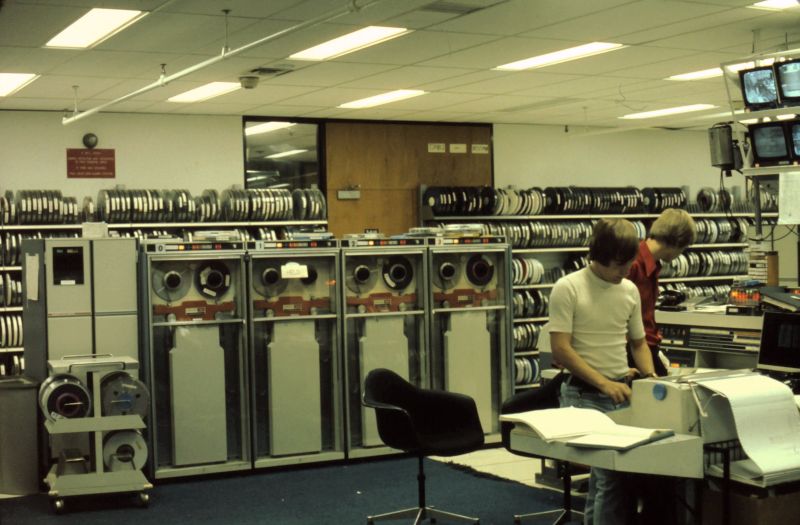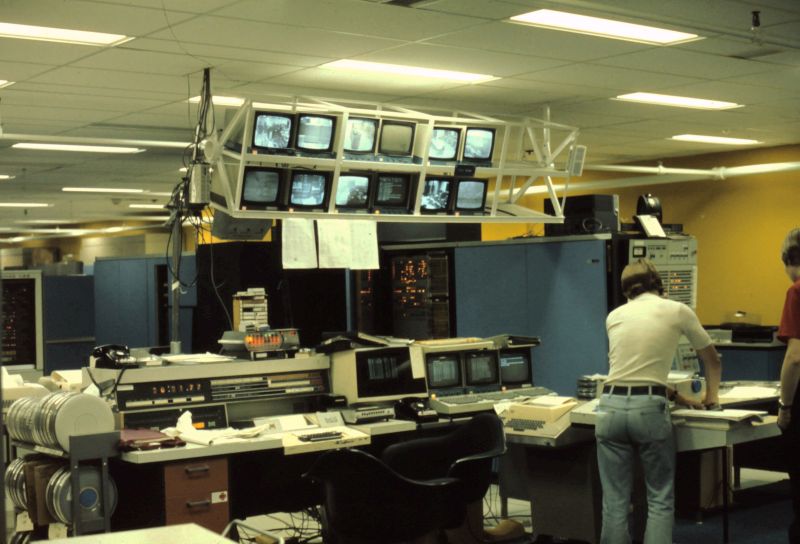These are to my knowledge the only photos I ever took of the 1108 and 360. When they were moved to Wean, summer 1971, they were placed with the consoles right next to each other. The three photos in this email are kind of a pan, from left to right(although the photographer, me, did move a bit between photos). The first one shows the 1108 tape drives, the second one the 1108 and its console and the third one the 360 (with the DAT unit open) although you can still see the 1108 console in the leftof this photo. I have no idea who were the two young men operating the machines. Both at the time I made the photographs were attending the 360 and although you can see tapes mounted on the 1108, it did not appear to be doing anything while I was there.
I hope you've all enjoyed this little trip down memory lane (is that core memory ;-)
While searching for these slides, I came across another surprise. For some forgotten reason, I had acquired a single roll of Anscochrome film and exposed it likely in spring 1969, but I could be off a year either way. I know its spring because the shots at the end of the roll are of the midway at spring carnival and some buggy race shots as well. Why, as my father worked for Eastman Kodak (and I worked there summers at that time as well) and I was religious about using Kodak film, I don't know. Further, I didn't get the roll processed until 1975. This I do remember as I recall finding it and almost throwing it out but having completely forgotten what was on it finally deciding to get it processed. Once again it was forgotten until I just went slide mining. This is the first time I've ventured to look at these slides in over 20 years. Nothing really interesting in this one roll except the early construction (actually more destruction, lots of holes being dug in the ground) of Wean Hall. That's why I'm assuming it was spring 1969 as I believe the project was underway by that time, but again I could be a year off either way. Do any of you have better information about the timing of the construction of Wean? Anyway, I have not yet scanned any of these slides. Are any of you interested in seeing a few of them?
My next scanning project is likely to be of some of those Tri-X negatives I took in 66 and 67. I believe I know where they are. I haven't looked at those since I rescued (most of) them from a flood in the early 70's. I don't know how much if any of them will be of interest to you all. We shall see...
73,
Chris Hausler

The 1108 tape drives
Clem Cole <clemc@ccc.com>
Sent: Oct 2, 2017 8:02
PM
To: "J. Chris Hausler"
Subject: Your CMU Computer Center
Photo's
I just
ran across these CMU Photos from Chris Hausler.html photo's and you ask who the
people are. The guy in the white shirt is 'Little Kid' who's name I now
forget, but if I ask John Sontag he might remember. That's me, Clem Cole in the
Red shirt. The time frame was probably fall '75 by the looks of what is in the room
at the time.
Clem

The 1108 and its console

The 360 (with the DAT unit open) although you can still see the 1108 console in the left of this photo


 earthlink.net>
earthlink.net>